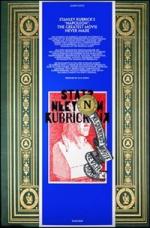|
This section contains 4,151 words (approx. 14 pages at 300 words per page) |

|
SOURCE: “Implied Metaphor in the Films of Stanley Kubrick,” in New Orleans Review, Vol. 16, No. 3, Fall, 1989, pp. 96-100.
In the following essay, Collins investigates Kubrick's use of image and metaphor in his films.
More than the average director of the current movie era, Stanley Kubrick relies on image and metaphor to underscore both the tone and overall significance of crucial scenes within his films. For Kubrick, the visual effects in film compose at least seventy-five percent of the narrative process. While camera angles, voice-over narration and musical accompaniment serve their traditional uses in his productions, Kubrick often strikes resonances by giving visual and aural devices new contexts and meanings.
The use of image and metaphor lends violence a curious pitch and hue in Kubrick's A Clockwork Orange. When Alex and his “droogs” call on the unwary novelist, his wife is shown sitting in a chair of round, “modish...
|
This section contains 4,151 words (approx. 14 pages at 300 words per page) |

|


